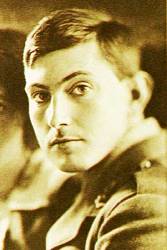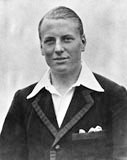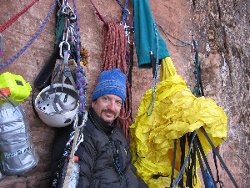
Left: George Mallory and Andrew Irvine © RGS/The Sandy Irvine Trust, from "Ghosts of Everest" ; Right: 1924 North Face locations © Pete Poston
| Photoanalysis | Routes & Maps | Video & Books | Contact Me |


"I'm quite doubtful if I shall be fit enough. But again I wonder if the monsoon will give us a chance. I don't want to get caught, but our three-day scheme from the Chang La will give the monsoon a good chance. We shall be going up again the day after tomorrow. Six days to the top from this camp!"
--from George Mallory's last letter to his wife prior to disappearing on Mt. Everest with his partner Andrew "Sandy" Irvine in 1924
"My face is in perfect agony. Have prepared two oxygen apparatus for our start tomorrow morning".
- Sandy Irvine's last diary entry

Interview with Graham Hoyland, author of the new book “Last Hours on Everest - The gripping story of Mallory and Irvine's fatal ascent”
by Pete Poston
Graham Hoyland requires no introduction; a well-known producer for the BBC, sailor, explorer, and mountaineer, who climbed Everest from the South side in 1993. Currently Hoyland is working to complete his latest project, known as Seven Seas-Seven Summits, where he hopes to be the first person to climb the seven highest peaks on each continent, while simultaneously sailing all the Seven Seas.
When only 11 years old, Hoyland’s life was forever changed when he met his Great Uncle Howard Somervell, who told him a fascinating tale of the 1924 British attempt to climb Mount Everest from the North. Somervell was a member of this expedition along with George Mallory and Andrew Irvine, who disappeared forever on their famous summit attempt.
The tale that Somervell told his nephew was about how he had lent his personal camera to the perennially absent-minded Mallory, who had lost his somewhere, and that if the camera could be recovered somehow, the images that it might contain could possibly prove if they summited or not. It became Hoyland’s quest to find his Great Uncle’s camera.
There have been many searches for Irvine and the camera, and Hoyland has been on no less than nine of them over the years since his first attempt in 1990 with David Breashears. In his latest book, “Last Hours on Everest - The gripping story of Mallory and Irvine's fatal ascent”, Hoyland relates a tale of25 years of searching for Irvine and the camera. But it is also a tale of inner discovery, and a sometimes very personal and honest tale of life’s successes and failures.
Well, let’s start out on a lighter note. You have a reputation as liking to drink a pint or two. What do you prefer, an ale, porter, stout or something else?
I like warm English real ale, like Bishop’s Finger or Buttcombe’s Old Todger. I’d love to try the American Craft beers such as Moose Drool and Giggling Beaver, but I can only manage two pints before becoming sleepy and passing out. I’m no Hemingway. To be honest, I prefer a glass of good wine, and then a dram of Bowmore Enigma Single Malt whisky before bed.
Silly question - how do you pronounce Irvine; is it Ir-vin (like win), or Ir-vine (like wine)?
This is not a silly question at all. I like correct pronunciation. It is Ir-vin, like win. But it is not as simple as that; Sir George Everest pronounced his name Eve-erest, as in Adam and Eve. Do we follow that?”
What got you into sailing? What progress have you made to fulfill your Seven Continents – Seven Summits quest?
As I child I was always playing around water. The book “Bevis” was the inspiration. I remember climbing into an old bath tub aged around seven, and pushing off down a small river near the family home in Rutland. The branches were brushing past, and new vistas of the river downstream opened up. At that moment I decided I wanted to be an adventurer. So far I have sailed on a 60 foot yacht from Australia, sailed across the Southern Ocean, landed on Antarctica and back again. We were looking for the South Magnetic Pole, which keeps moving. Just recently we took my expedition yacht from the US to Cuba, then down to the Caribbean islands via the Thorny Path. Next is South America. In 2015 I hope to sail around the perimeter of the Arctic Ocean with an old friend. But who knows what will happen next?”
The book seems to be more of a personal journey than simple nonfiction. Would you say that you have been obsessed with finding Irvine’s camera, and is obsession one of the central themes of the book?
Well spotted! There’s been a number of excellent reviews for Last Hours on Everest” but none of them touches on the hidden message. As well as a detective story, the book is a dissertation on Belief: why we want to believe certain things, and which things get chosen to be the object of our belief- or worship. Things like gods and mountains. I wanted to believe that Mallory had got to the summit of his mountain, and like any other religious person I was prepared to ignore scientific evidence which conflicted with my particular point of view. Examining the evidence made me realise that I had to change my mind. Therefore I would say that I wasn’t a proper obsessive, as they will plough on, disregarding any evidence to the contrary.
You summited Everest from the south in 1993. Why did you climb Everest post-monsoon? Didn’t your expedition do a lot of the route preparation yourselves? What were the conditions like?
Climbing Everest was slightly different in those days. Not many permits were issued, so we had to choose an unpopular time of year to attempt the mountain: post-monsoon. Instead of getting warmer as the expedition progresses, as it does pre-monsoon, on our trip it got colder and colder as we got higher. Only around 5% of successful climbs are made post-monsoon. After we carried loads up to Camp 3, the whole Lhotse face was swept by an avalanche. We lost everything and had to trim down the expedition numbers and re-establish the camp, with the Sherpas working flat out as usual. Then the leader Steve and I had to put four tents up ourselves on the South Col. In the end we topped out with a lenticular cloud right over us, an indication of high winds clearly visible from Base Camp. You could say it was a bit chilly. I was just very lucky to get up at all.
Of course everyone is excited about your revelation that there was a sighting in 1933 by Frank Smythe, member of the 1933 British Everest Expedition, who used a high-power telescope to scan the terrain below the ice ax site for any signs of the missing climbers. How much credibility should we give to this sighting given that Smythe was using a telescope 12 miles away in base camp? Do you know anything about the make and power of this telescope? Is it now with the Royal Geographical Society?
Mallory and Irvine aficionado Ralph Wondraschek, an astronomer familiar with the resolution of telescopes, has explained that it was perfectly possible for Smythe to have seen a body just as they had already seen the small Meade tents at Camp 6, located at over 27,000’, all the way from base camp. I do believe that Smythe saw one of the bodies. When he saw the body of my uncle John Hoyland on Mont Blanc he was reminded of his sighting on Everest the previous year. Anyone who has seen a body on a mountain will tell you that they have a huddled sort of look, that isn’t snow, and isn’t rock. I know nothing about the telescope, just that pre-War optics were up to the job.”
Are there any other family secrets that you haven’t revealed yet, or can you give us a teaser?
Yes. And no.”
You interviewed Xu Jing in 2003. Was his account consistent or inconsistent with other interviews? Are there any little tidbits you can reveal that perhaps haven’t made it into the popular literature?
All I can say is that the descriptions of the topography seemed inconsistent with other interviews. See below about eye-witnesses.”
Based on Xu Jing’s sighting, most researchers seem convinced that Irvine's body remains somewhere up in or around the Yellow Band. How likely is it in your opinion, that Irvine simply tumbled on past Mallory and is resting somewhere further down the Face?
It is possible, I suppose. Maybe that is what Smythe saw. Someone should go and look.”
Another sighting of an old body above 8400 meters was made by Chhiring Dorje Sherpa, whom you personally know and have been on the mountain with. Has Chhiring Dorje ever given more exact details of what he saw, including a more precise location, e.g near the two towers by the Exit Cracks, near the Green Boots cave, etc.?
No. Much as I love the Sherpas, most of the reports seem inconsistent, which is why I deal with the reliability of eyewitnesses in the book. Visual witnesses are notoriously unreliable, as many studies have shown. The so-called ‘forgetting curve’ effect means that visual memory is already disappearing within twenty minutes, and Odell, for example, did not make his diary entry until a long time after his high-altitude sighting. Smythe, on the other hand, was unstressed at base camp. The effects of high altitude and stress have also been well documented by Jon Krakauer, among others. The problem is that eyewitnesses are generally given a great deal of credence in courts of law.
How many searches have you mounted? What different areas of the North Face have you covered, e.g. below the ice ax site, the gullies leading down into the Yellow Band, etc?
Whenever I was on the relevant parts of the mountain during my 9 expeditions I would ask the Sherpas to search another new area, striking off each area as it was covered. This had to be done in secrecy. I couldn’t do the search myself effectively as the Sherpas are far better at working at altitude than we Westerners are. The new research on why this is so is presented in the book (it seems to be about capillaries). We covered all the areas you’d think of, and some you wouldn’t. One area not properly covered is below Mallory, because the Sherpas had no good reason to be down there. Smythe may have seen Irvine’s body below that of Mallory, in a gully, on the fall line. If someone finds him, develops the film in Somervell’s camera and proves that Mallory and Irvine climbed to the summit I for one will be delighted.
And now for some of the more controversial subjects in the book. Why do you claim that the 1999 M&I research expedition was started by you? Wasn’t it Jochen Hemmleb and Eric Simonson?
As I explain in “Last Hours on Everest”, I was first told of the missing camera by Howard Somervell in 1969. I started mountaineering with the intention of recovering it. In 1990 I was high on Everest’s North Ridge with David Breashears, only a few hundred yards away from Mallory’s body. I climbed Everest in 1993. I then spent five years persuading the BBC to fund an expedition to look for the camera- which meant finding Irvine or Mallory. At last, in 1998 the money was granted, and the programme commissioned. Then, as you will read, at the last minute things changed somewhat. My name was on their original expedition paperwork as “co-founder”. No-one in the UK had any doubt about who started this particular expedition.
That is not to denigrate Jochen or Eric, on the one hand Jochen’s meticulous research and on the other hand Eric’s powerful leadership were a powerful combination.
You’re critical of Tom Holzel in the book. Why is that?
I wasted a great of time in my researches assuming that Tom knew what he was talking about with such authority. To be fair to him, he did help to stoke the modern interest in the fate of the Everest climbers Mallory and Irvine. Collaborating with Audrey Salkeld, he published a book “The Mystery of Mallory and Irvine”. In one of the two chapters signed by him he made a number of assumptions which have been proved to be wrong. Let’s go through them:
(a) Tom seemed to believe in 1971 that climbers could not reach the summit without oxygen, a theory that was soon proved wrong by Reinhold Messner and Peter Habeler. So he had to invent a complicated sequence of events in which Odell sees the two climbers on the Second Step, and he has them climb it in five minutes. Mallory then takes Irvine’s remaining oxygen and leaves him at the top of the Step. Splitting up at 1 p.m., Mallory quickly raced up the final pyramid. This is glorious stuff, and utterly silly. I don’t think I’ve ever seen anyone quickly racing up anything at Everest Base Camp, let alone near the summit. Holzel has not climbed Everest, as I have, but even he must have realised that walking very slowly and taking around ten breaths per step is the most you can manage on the summit.
(b) So Holzel has Mallory nipping up the Second Step in 5 minutes, whereas every serious climber I have ever asked thought he was extremely unlikely to have gone that way. David Breashears said to me “Look at his boots. There’s no way he would have tried the Second Step wearing those.” I believe Jim Wickwire agrees. Mallory’s peers on all the early expeditions described the route as “utterly impregnable.” Despite the fact that it would have been technically difficult for Mallory, even at sea level, to tackle the climb, he was also carrying an enormous oxygen set. In “Last Hours on Everest” I reveal another reason: there was no decent belay from which Irvine could protect him.
(c) Tom then has Mallory sitting out the night dressed in “hacking jacket and muffler” In fact, as I show in my book, his gear was rather more sophisticated than that, and was cutting-edge polar technology. However, it probably wasn’t up to the prevailing weather conditions. Which brings me on to....
(d) Weather: instead of Tom’s claim that Mallory and Irvine had “unusually benign circumstances” for their climb, in fact they were climbing up into a death-trap. In the book I reveal (in a peer-reviewed meteorological paper which I co-authored), that the storm was even worse than the Into Thin Air” 1996 storm. Because of the low pressure they effectively had a higher mountain to climb.
(e) Turning to modern times, Tom seems to cast doubt on my previously-unpublished Frank Smythe’s sighting of Mallory’s or Irvine’s body. He suggests that: “Smythe's primitive pre- WW-II lenses could not possibly have resolved anything as distinct as a six-foot object at that distance...” In fact, as astronomer Ralph Wondraschek has explained , those pre-War lenses were able to resolve a 20 centimetre (8 inch) object with the eye: So from base camp, with a 60 mm scope at min 60 x, objects of 20 cm diameter can be discerned on Everest's North face (by the eye, NOT by early film emulsions).”
Holzel has posted a very negative review of your book on Amazon.com. Any clarifications?
It is unwise to review other writers badly, especially when the other reviews are glowing. It is particularly unwise to do this when it might be mistaken for pique.
So far I have had five 5-star reviews on Amazon.com and Amazon.co.uk, and one 2-star review from Tom. Go figure. A famous American climber privately described this to me as a hatchet job. However, the controversy seems to be stimulating sales as we have nearly sold out of the first printing run.
Getting rather personal, Holzel describes you as a “Johnny-Come-Lately”.
As I heard the story from Mallory’s friend and climbing companion, Howard Somervell in 1969 I’m afraid I even pre-date the Venerable Tom. I’ve been hunting for the truth all the way up to the summit ever since. He has sat at Advanced Base Camp once. Having said all this, if I met Tom I would probably like him. I enjoy people who like a good debate, especially when they get it all wrong, change their mind, and then attack their original critics for agreeing with them.
Mallory and Irvine were engulfed in a severe afternoon storm, probably at around 28,000’ after their oxygen ran out, wearing clothing only adequate for good conditions. Were they pretty much doomed from this point on?
Not necessarily. Descent is perfectly possible without oxygen sets, in fact they would have gone better without them. And I think they could have got down alive in their adequate clothing, and then we wouldn’t have even heard much of Mallory, let alone be still discussing him. However, most accidents seem to happen on the descent, when a climber’s guard is relaxed.
Regardless of climber pairings, do you feel the technology, knowledge and climbing skills possessed by the 1924 expedition were sufficient to conquer the summit of Everest?
Yes, I do. By 1924 the British knew enough about hydration, nutrition, clothing and oxygen systems to make a successful attempt. In my book I reveal my new research based on Somervell's records which shows just how unlucky Mallory and Irvine were in one other, vital area.
The legal issues surrounding British copyright law are very complicated, having undergone several modifications since 1924. Besides the obvious development of the film, what would you do with the camera and film if you ever find it?
I would give the camera and film to its rightful owners, the Somervell family, and ask them to have the film developed.
How would you handle photographs of Irvine’s remains? Have you discussed the matter with the Irvine family? What is their position on searching for Irvine in general?
I think publishing pictures of climbers’ remains is unwise. I have discussed the matter with the Irvine family, and they are in agreement with me.
As a final question, you seem to have come to the end of your involvement with Mallory and Irvine. Besides a simple moving on to other things, why is that?
Finally, the reason I have taken up sailing, and left the Mallory and Irvine subject for others to pursue, is because I have given it all that I’ve got. There comes a time when you just have to hand the baton on to the next generation of researchers. As I say in Last Hours on Everest”, I hope someone will now use that previously unrevealed Smythe sighting to find the camera and discover the truth. Whatever that is.

Articles and Editorials
![]() Harvey V. Lankford, MD, has written a paper documenting the origin of the term "Glacier Lassitude" as a diagnosis for the debilitating effect of altitude as experienced by members of the early British Everest expeditions.
Harvey V. Lankford, MD, has written a paper documenting the origin of the term "Glacier Lassitude" as a diagnosis for the debilitating effect of altitude as experienced by members of the early British Everest expeditions.
![]() My new theory about Mallory and Irvine's last climb, where I believe Odell's sighting was erroneous, and have them taking the Couloir route instead.
My new theory about Mallory and Irvine's last climb, where I believe Odell's sighting was erroneous, and have them taking the Couloir route instead.
Part 1: the ascent
Part 2: the descent
![]() Warwick Pryce is a new researcher who has arrived on the scene, and he has a new theory about how Andrew Irvine could have been the first person to stand on the top of the world.
Warwick Pryce is a new researcher who has arrived on the scene, and he has a new theory about how Andrew Irvine could have been the first person to stand on the top of the world.
Wim Kohsiek has a new interpretation of what Mallory's altimeter can tell us based on scientific applications of meterology.
Mallory and Irvine researcher Wim Kohsiek has two new thought-provoking articles about Mallory's watch and Irvine's location:
Mallory's Watch - Does it Really Point to 12:50 PM?
1924 Oxygen by Richard McQuet and Pete Poston
Why the Camera and Film are not Doomed to Destruction!
The Politics of Mallory and Irvine
Why Andrew Irvine Will Not be Found in a Sleeping Bag! Part 1 and Part 2 on ExplorersWeb
Chomolungma Nirvana: The Routes of Mount Everest
Rust Marks on Mallory's Altimeter
Mystery of Mallory and Irvine's Fate Google Earth Tour - my own ideas in 3-D with audio!
Little Known Free-Solo Ascent of the Second Step in 2001 by Theo Fritsche - I should never have written this - Anker and Houlding deserve credit for the first free ascent
Criticisms of the 2004 EverestNews.com search for Irvine --
The Mystery of Mallory and Irvine's Fate (with J. Hemmleb): Part 1, Part 2, Part 3, Part 4, Part 5.
Mallory and Irvine - Comments on the 'real Second Step' route: Part 1 and Part 2
Conrad Anker's comments on the unlikeliness of a direct route up the prow of the 2nd Step
Articles about my heroes Walter Bonatti and Chris Bonington --
Spilling the Beans - Lino Lacedelli's Book "Price of Conquest: Confessions from the First Ascent of K2" Part 1 and Part 2
The Life and Climbs of Chris Bonington, Part 1, Part 2, Part 3, Part 4, Part 5 final - interview
About Me
 Celebrating my 50th birthday on pitch 3 of Prodigal Son, Zion National Park, Utah
Celebrating my 50th birthday on pitch 3 of Prodigal Son, Zion National Park, Utah
In my free time, I love to photograph and hike the spectacular redrock wilderness of the Colorado Plateau - please visit my Colorado Plateau Homepage.
And for most of my life I've been fascinated with the history, people, and culture of the Himalayas and Karakoram - browse my Mount Everest Trek (1996), Overland Journey from Kathmandu to Lhasa (2000), and K2 Base Camp Trek (2007) webpages.
As for my employment, I work for Western Oregon University where I have been a Professor of Chemistry for the last 20 years. My research interests are in applications of Laser Raman Spectroscopy to such diverse fields as Nanotechnology, Analytical Chemistry, and even a bit of Achaeology through the study of rock art pigments found in the Colorado Plateau. You can access my academic webpage here.

|
Copyright (c) 2004-2022 Pete Poston. All rights reserved. Visitor's Agreement |